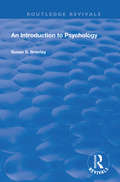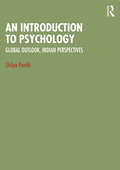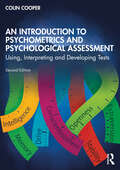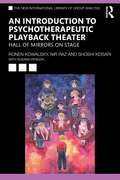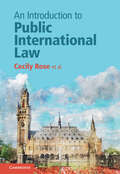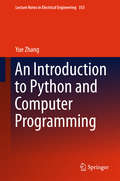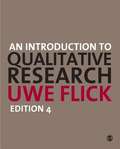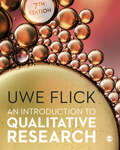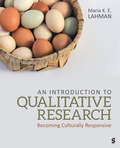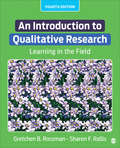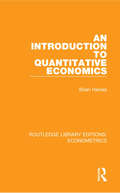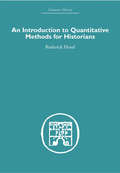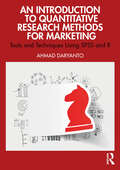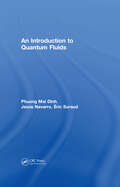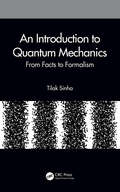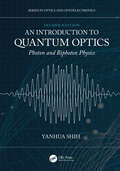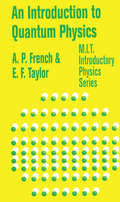- Table View
- List View
An Introduction to Psychology (Routledge Revivals)
by Susan S. BrierleyOriginally published in 1921, this introduction to psychology includes chapters on the definitions and methods related to psychology; organism and environnment; and instinct and intelligence.
An Introduction to Psychology: Global Outlook, Indian Perspectives
by Shilpa PanditThis textbook provides an essential, contextually sensitive and culturally relevant grounding in Psychology that sets the base for future studies. Replete with discussions on current themes and debates in the discipline, its interdisciplinary linkages are relevant in the current times in terms of their contributions and application.This volume addresses the overarching questions of the discipline, with chapters organised to discuss psychological concepts, theories and principles in the light of cultural world views, where culture and the psyche are interdependent. It discusses the indigenous views of self and consciousness as well as contemporary applications of psychology in the global world.This book, designed for a global readership, would be useful to the students and teachers of Psychology, Applied Psychology, and Sociology, and Social Work, Public Health, Gender and Women Studies.
An Introduction to Psychometrics and Psychological Assessment: Using, Interpreting and Developing Tests
by Colin CooperAn Introduction to Psychometrics and Psychological Assessment is the successor to Cooper’s prize-winning book Psychological Testing: Theory and Practice. This expanded and updated volume shows how psychological questionnaires and tests can be chosen, administered, scored, interpreted and developed. In providing students, researchers, test users, test developers and practitioners in the social sciences, education and health with an evaluative guide to choosing, using, interpreting and developing tests, it provides readers a thorough grasp of the principles (and limitations) of testing, together with the necessary methodological detail. This book has three distinctive features. First, it stresses the basic logic of psychological assessment without getting bogged down with mathematics; the spreadsheet simulations and utilities which are integrated into the text allow users to explore how numbers behave, rather than reading equations. Readers will "learn by doing". Second, it covers both the theory behind psychological assessment and the practicalities of locating, designing and using tests and interpreting their scores. Finally, it is evaluative. Rather than just describing concepts such as test reliability or adaptive testing, it stresses the underlying principles, merits and drawbacks of each approach to assessment, and methods of developing and evaluating questionnaires and tests. Unusually for an introductory text, it includes coverage of several cutting-edge techniques, and this new edition expands the discussion on measurement invariance, methods of detecting/quantifying bias and hierarchical factor models, and features added sections on: - Best practices for translation of tests into other languages and problems of cultural bias - Automatic item generation - The advantages, drawbacks and practicalities of internet-based testing - Generalizability theory - Network analysis - Dangerous assumptions made when scoring tests - The accuracy of tests used for assessing individuals - The two-way relationship between psychometrics and psychological theory. Aimed at non-mathematicians, this friendly and engaging text will help you to understand the fundamental principles of psychometrics that underpin the measurement of any human characteristic using any psychological test. Written by a leading figure in the field and accompanied by additional resources, including a set of spreadsheets which use simulated data and other techniques to illustrate important issues, this is an essential introduction for all students of psychology and related disciplines. It assumes very little statistical background and is written for students studying psychological assessment or psychometrics, and for researchers and practitioners who use questionnaires and tests to measure personality, cognitive abilities, educational attainment, mood or motivation.
An Introduction to Psychotherapeutic Playback Theater: Hall of Mirrors on Stage (The New International Library of Group Analysis)
by Ronen Kowalsky Nir Raz Shoshi KeisariAn Introduction to Psychotherapeutic Playback Theater is a comprehensive book presenting Psychotherapeutic Playback Theater as a unique form of group psychotherapy. This pioneering book is the first of its kind, examining this new approach, the theory behind it, and the numerous considerations and diverse possibilities involved in using the technique to promote a significant reflective process among participants. Informed by years of Psychotherapeutic Playback Theater practice and research, the authors detail a collective-creative method that allows for the creation of a therapeutic experience centered on feelings of belonging, acceptance, visibility and liberation. It is presented to the reader as a path toward their development and growth as a conductor working in this newly evolving field of group therapy. The book will be of great interest to dramatherapy students, trainees and professionals, and group therapists who wish to reflect upon their practice through the mirror of Psychotherapeutic Playback Theater as well as facilitators and actors working with Playback Theater or other improvised genres.
An Introduction to Public International Law
by Nico Schrijver Robert Heinsch Cecily Rose Niels Blokker Daniëlla Dam-de Jong Simone van den Driest Erik KoppeWritten for students working in a range of disciplines, this textbook provides an accessible, balanced, and nuanced introduction to the field of public international law. It explains the basic concepts and legal frameworks of public international law while acknowledging the field's inherent complexities and controversies. Featuring numerous carefully chosen and clearly explained examples, it demonstrates how the law applies in practice, and public international law's pervasive influence on world affairs, both past and present. Aiming not to over-emphasize any particular domestic jurisprudence or research interest, this textbook offers a global overview of public international law that will be highly valuable to any student new to the study of this very significant field.
An Introduction to Python and Computer Programming (Lecture Notes in Electrical Engineering #353)
by Yue ZhangThis book introduces Python programming language and fundamental concepts in algorithms and computing. Its target audience includes students and engineers with little or no background in programming, who need to master a practical programming language and learn the basic thinking in computer science/programming. The main contents come from lecture notes for engineering students from all disciplines, and has received high ratings. Its materials and ordering have been adjusted repeatedly according to classroom reception. Compared to alternative textbooks in the market, this book introduces the underlying Python implementation of number, string, list, tuple, dict, function, class, instance and module objects in a consistent and easy-to-understand way, making assignment, function definition, function call, mutability and binding environments understandable inside-out. By giving the abstraction of implementation mechanisms, this book builds a solid understanding of the Python programming language.
An Introduction to Qualitative Research
by Dr Uwe FlickThe definitive guide to the full qualitative research process, from design to dissemination, this is everything you need to understand how good quality research is produced, and how to use and enrich your own work with it. New to this edition: - A new structure follows the research process step-by-step - Brand new chapter on digital methods and social media data explores cutting-edge research - Multi-disciplinary case studies give you real research examples whatever your subject - Focused reading exercises help you explore the literature and build a better bibliography - Integrated online resources, to master the key concepts, discover real research and track your progress An Introduction to Qualitative Research has everything a social science student needs to understand and explore the richness of qualitative research.
An Introduction to Qualitative Research
by Dr Uwe FlickThe definitive guide to the full qualitative research process, from design to dissemination, this is everything you need to understand how good quality research is produced, and how to use and enrich your own work with it. New to this edition: - A new structure follows the research process step-by-step - Brand new chapter on digital methods and social media data explores cutting-edge research - Multi-disciplinary case studies give you real research examples whatever your subject - Focused reading exercises help you explore the literature and build a better bibliography - Integrated online resources, to master the key concepts, discover real research and track your progress An Introduction to Qualitative Research has everything a social science student needs to understand and explore the richness of qualitative research.
An Introduction to Qualitative Research
by Uwe FlickA new edition of this book is available `Flick's An Introduction to Qualitative Research is quite simply the most important text on qualitative research methods in the world today. I continue to envy Flick's command of the field and its ever-expanding literature, much of which he has managed to include in his new edition' - Norman K Denzin, University of Illinois, Urbana-Champaign `Flick aims to please both the novice and the experienced researcher, and in his ambition he largely succeeds. . . . From conceptualizing the field, making sampling decisions to constructing interview guides, Flick offers practical counsel' - Science Direct `Ideal for anyone wishing to understand fully the theoretical constructs behind the qualitative research methodology' - Journal of Family Studies `The inclusion of examples, summary points and further reading is to be commended and adds to the clarity of an already clear and easy to understand text. The strength of the book lies not only in the clarity with which it is written but in the use of examples and tables. . . . I would have no problem in recommending this text equally to both pre and post-registration students of nursing, and also to students studying for higher degrees as a useable text which is easy to read and contains a vast amount of information which is logically presented' - Nurse Researcher This Third Edition of Uwe Flick's bestselling textbook has been fully revised, expanded and updated but retains all of the student-friendly elements and carefully structured qualities of the previous edition. Brand new features include: - Updated discussions and references throughout the text - The integration into all chapters of additional features including chapter overviews, case studies, lists of key points and end-of-chapter exercises - 6 new chapters including a guide to using the book, a chapter on ethics, the uses of literature in qualitative research, an overview of research design, a discussion centred on using documents, and a final chapter on qualitative online research. This new edition will ensure that An Introduction to Qualitative Research preserves its status as the essential introductory text for all students of qualitative research.
An Introduction to Qualitative Research
by Uwe FlickContinuing to be THE guide to the whole qualitative research process for students, this book looks at both the theory behind qualitative research and how to put it into practice in your own work. For students across a range of social science disciplines and beyond, this is a must to help you enhance your research project. This edition introduces: a decolonisation of methodologies a range of indigenous, queer and feminist perspectives on methodologies assistance with defending a viva and alternative forms of assessment to suit a changing world. More additions to this seventh edition include a section on the subjectivity of a researcher, and how your identity will shape your research. The further reading has been curated to include more than just western voices, providing you with global perspectives on qualitative research. This text introduces how to sensitively undertake ethical and inclusive research with marginalised groups. This book will help you master a comprehensive understanding of qualitative research.
An Introduction to Qualitative Research
by Uwe FlickContinuing to be THE guide to the whole qualitative research process for students, this book looks at both the theory behind qualitative research and how to put it into practice in your own work. For students across a range of social science disciplines and beyond, this is a must to help you enhance your research project. This edition introduces: a decolonisation of methodologies a range of indigenous, queer and feminist perspectives on methodologies assistance with defending a viva and alternative forms of assessment to suit a changing world. More additions to this seventh edition include a section on the subjectivity of a researcher, and how your identity will shape your research. The further reading has been curated to include more than just western voices, providing you with global perspectives on qualitative research. This text introduces how to sensitively undertake ethical and inclusive research with marginalised groups. This book will help you master a comprehensive understanding of qualitative research.
An Introduction to Qualitative Research Synthesis: Managing the Information Explosion in Social Science Research
by Claire Howell Major Maggi Savin-BadenProviding a comprehensive guide for understanding, interpreting and synthesizing qualitative studies, An Introduction to Qualitative Research Synthesis shows how data can be collated together effectively to summarise existing bodies of knowledge and to create a more complete picture of findings across different studies The authors describe qualitative research synthesis and argue for its use, describing the process of data analysis, synthesis and interpretation and provide specific details and examples of how the approach works in practice. This accessible book: fully explains the qualitative research synthesis approach; provides advice and examples of findings; describes the process of establishing credibility in the research process; provides annotated examples of the work in process; references published examples of the approach across a wide variety of fields. Helping researchers to understand, make meaning and synthesize a wide variety of datasets, this book is broad in scope yet practical in approach. It will be beneficial to those working in social science disciplines, including researchers, teachers, students and policy makers, especially those interested in methods of synthesis such as meta-ethnography, qualitative meta-analysis, qualitative meta-synthesis, interpretive synthesis, narrative synthesis, and qualitative systematic review.
An Introduction to Qualitative Research: Bachman, The Practice Of Research In Criminology And Criminal Justice 4e + Flick, An Introduction To Qualitative Research 4e
by Dr Uwe Flick\In the new edition of his bestselling book, Uwe Flick introduces all of the main theoretical approaches to qualitative research, and provides unmatched coverage of the full range of methods now available to qualitative researchers. Organised around the process of doing qualitative research, the book guides you through ethics, research design, data collection, and data analysis. <P><P> In this fifth edition, you will find:<P> * a new chapter outlining methodological approaches to qualitative research <P> * new introductory sections at the beginning of each of the book's seven parts, which prepare the ground and define key terms <P> * lots of new practical examples which show you how to carry out all aspects of a qualitative research project <P> * new exercises that give you the opportunity to test your understanding of what you've read <P> * a brand new companion website full of resources for lecturers and students including suggested answers to the exercises in the book, full text journal articles and links to additional resources: http://uk.sagepub.com/flick5e
An Introduction to Qualitative Research: Becoming Culturally Responsive
by Maria K. LahmanThis engaging introduction to all aspects of qualitative research challenges students to consider how their research can be culturally responsive. The first part of the book introduces the foundations including theory, ethics, and reflexivity, with an emphasis on multiple methodologies, from traditional to critical and cutting-edge. The second part covers practical guidance from writing proposals to data collection, and includes a chapter dedicated to creating a culturally responsive relationship with research participants. Finally, readers engage with how the quality of research is enhanced, how data are analyzed, and how research accounts are created and disseminated. Areas vital to the health of qualitative research are addressed including systemic racism and cultural humility, with cutting-edge suggestions offered in areas like hybrid research, harnessing technology, and use of social media. Multiple identities are centered in examples throughout including race, gender, and those who are hard to reach or seldom heard in research. Textboxes featuring scholars, student researchers, and community members invite readers into dialogue in an area that is contested, swiftly shifting, and always vibrant with potential. Resources for instructors are available on a website to accompany the book at: https://edge.sagepub.com/lahman
An Introduction to Qualitative Research: Becoming Culturally Responsive
by Maria K. LahmanThis engaging introduction to all aspects of qualitative research challenges students to consider how their research can be culturally responsive. The first part of the book introduces the foundations including theory, ethics, and reflexivity, with an emphasis on multiple methodologies, from traditional to critical and cutting-edge. The second part covers practical guidance from writing proposals to data collection, and includes a chapter dedicated to creating a culturally responsive relationship with research participants. Finally, readers engage with how the quality of research is enhanced, how data are analyzed, and how research accounts are created and disseminated. Areas vital to the health of qualitative research are addressed including systemic racism and cultural humility, with cutting-edge suggestions offered in areas like hybrid research, harnessing technology, and use of social media. Multiple identities are centered in examples throughout including race, gender, and those who are hard to reach or seldom heard in research. Textboxes featuring scholars, student researchers, and community members invite readers into dialogue in an area that is contested, swiftly shifting, and always vibrant with potential. Resources for instructors are available on a website to accompany the book at: https://edge.sagepub.com/lahman
An Introduction to Qualitative Research: Learning in the Field
by Sharon F Rallis Gretchen B RossmanThe updated Fourth Edition of Rossman and Rallis’s popular introductory text leads the new researcher into the field by explaining the core concepts through theory, research, and applied examples. Woven into the chapters are three themes that are the heart of the book: first, research is about learning; second, research can and should be useful; and finally, a researcher should practice the highest ethical standards to ensure that a study is trustworthy. The Fourth Edition includes an elaborate discussion of systematic inquiry as well as a nuanced discussion of developing a conceptual framework.
An Introduction to Qualitative Research: Learning in the Field
by Sharon F Rallis Gretchen B RossmanThe updated Fourth Edition of Rossman and Rallis’s popular introductory text leads the new researcher into the field by explaining the core concepts through theory, research, and applied examples. Woven into the chapters are three themes that are the heart of the book: first, research is about learning; second, research can and should be useful; and finally, a researcher should practice the highest ethical standards to ensure that a study is trustworthy. The Fourth Edition includes an elaborate discussion of systematic inquiry as well as a nuanced discussion of developing a conceptual framework.
An Introduction to Quantitative Economics (Routledge Library Editions: Econometrics #8)
by Brian HainesOriginally published in 1978. This book is designed to enable students on main courses in economics to comprehend literature which employs econometric techniques as a method of analysis, to use econometric techniques themselves to test hypotheses about economic relationships and to understand some of the difficulties involved in interpreting results. While the book is mainly aimed at second-year undergraduates undertaking courses in applied economics, its scope is sufficiently wide to take in students at postgraduate level who have no background in econometrics - it integrates fully the mathematical and statistical techniques used in econometrics with micro- and macroeconomic case studies.
An Introduction to Quantitative Methods for Historians (Economic History Ser.)
by Roderick FloudMany statements made by historians are quantitative statements, involving the use of measurable historical evidence. The historian who uses quantitative methods to analyse and interpret such information needs to be well acquainted with the particular methods and techniques of analysis and to be able to make the best use of the data that are available. There is an increasing need for training in such methods and in the interpretation of the large volume of literature now using quantitative techniques. Dr Floud’s text, which is relevant to all branches of historical inquiry, provides a straightforward and intelligible introduction for all students and research workers. The simpler and more useful techniques of descriptive and analytical statistics are described, up to the level of simple linear regression. Historical examples are used throughout, and great attention is paid to the need to ensure that the techniques are consistent with the quality of the data and with the historical problems they are intended to solve. Attention is paid to problems of the analysis of time series, which are of particular use to historians. No previous knowledge of statistics is assumed, and the simple mathematical techniques that are used are fully and clearly explained, without the use of more mathematical knowledge than is provided by an O-level course. A bibliography is provided to guide historians towards the most useful further reading. This student friendly text was first published in 1973.
An Introduction to Quantitative Research Methods for Marketing: Tools and Techniques Using SPSS and R
by Ahmad DaryantoThis introductory text covers the foundational concepts and statistical applications of quantitative research techniques using SPSS and R.Using step-by-step examples throughout, the book is broken down into six core sections: Part 1 covers an introduction to quantitative research methods and how to get started with SPSS and R; Part 2 covers basic concepts in measurement, data descriptions, and distributions; Part 3 discusses hypothesis testing, and basic statistical tests; Part 4 covers regression analysis; Part 5 discusses advanced topics in regression analysis and analysis of variance; and finally Part 6 covers advanced statistical methods. Each chapter contains learning objectives and summaries to structure learning, while breakout boxes provide tips and draw students’ attention to dos and don’ts in statistical research. SPSS and R Action Boxes present step-by-step instructions on how to perform statistical tests and procedures with SPSS and R. Review questions prompt self-reflection on concepts taught in each chapter and are complemented by exercises that allow students to put their learning into practice.A very applied text designed to make this complex subject accessible to students with no background in quantitative methods, this book is valuable recommended and core reading for advanced undergraduate and postgraduate students studying business and marketing research methods, business analytics, marketing analytics, statistical skills and quantitative methods.Online supplementary resources include data sets and programming files.
An Introduction to Quantitative Text Analysis for Linguistics: Reproducible Research Using R
by Jerid FrancomAn Introduction to Quantitative Text Analysis for Linguistics: Reproducible Research Using R is a pragmatic textbook that equips students and researchers with the essential concepts and practical programming skills needed to conduct quantitative text analysis in a reproducible manner. Designed for undergraduate students and those new to the field, this book assumes no prior experience with statistics or programming, making it an accessible resource for anyone embarking on their journey into quantitative text analysis.Through a pedagogical approach which emphasizes intuitive understanding over technical details, readers will gain data literacy by learning to identify, interpret, and evaluate data analysis procedures and results. They will also develop research skills, enabling them to design, implement, and communicate quantitative text analysis projects effectively. The book places a strong emphasis on programming skills, guiding readers through interactive lessons, tutorials, and lab activities using the R programming language and real-world datasets.This practical textbook is enriched with features that facilitate learning, including thought and practical exercises, a companion website that includes programming demonstrations to develop and augment readers’ recognition of how programming strategies are implemented, and a GitHub repository that contains both a set of interactive R programming lessons and lab exercises, which guide readers through practical hands-on programming applications. This textbook is an essential companion to any linguist looking to learn how to incorporate quantitative data analysis into their work.The Open Access version of this book, available at http://www.taylorfrancis.com, has been made available under a Creative Commons Attribution-Non Commercial-No Derivatives (CC-BY-NC-ND) 4.0 license.
An Introduction to Quantum Fluids
by Phuong Mai Dinh Eric Suraud Jesus NavarroWhat do atomic nuclei, neutron stars, a domestic power supply, and the stunning colors of stained glass in cathedrals all have in common? The answer lies in the unifying concept of quantum fluids, which allows us to understand the behavior and properties of these different systems in simple terms. This book reveals how quantum mechanics, usually considered as restricted to the invisible microscopic world, in fact plays a crucial role at all scales of the universe. The purpose of the book is to introduce the reader to the fascinating and multifaceted world of quantum fluids, which covers different systems at different scales in the physical world. The first part of the book discusses the notion of phases (solid, liquid, gas), presents basic aspects of the structure of matter and quantum mechanics, and includes some elements of statistical mechanics. The second part provides a description of the major quantum liquids, starting with the paramount case of electron fluids and their many applications in everyday life, followed by liquid helium and atomic nuclei. The authors go on to explore matter at very high densities, covering nuclear matter and compact stars, and the behavior of matter at extremely low temperatures, with the fascinating ‘superphases’ of superconductivity and superfluidity. The topic of quantum fluids has multidisciplinary applications and this book will appeal to students and researchers in physics, chemistry, astrophysics, engineering and materials science.
An Introduction to Quantum Mechanics: From Facts to Formalism
by Tilak SinhaThe core content of even the most intricate intellectual edifices is often a simple fact or idea. So is it with quantum mechanics; the entire mathematical fabric of the formal description of quantum mechanics stems essentially from the fact that quantum probabilities interfere (i.e., from the superposition principle). This book is dedicated to substantiating this claim. In the process, the book tries to demonstrate how the factual content of quantum mechanics can be transcribed in the formal language of vector spaces and linear transformations by disentangling the empirical content from the usual formal description. More importantly, it tries to bring out what this transcription achieves. The book uses a pedagogic strategy which reverse engineers the postulates of quantum mechanics to device a schematic outline of the empirical content of quantum mechanics from which the postulates are then reconstructed step by step. This strategy is adopted to avoid the disconcerting details of actual experiments (however simplified) to spare the beginner of issues that lurk in the fragile foundations of the subject. In the Copenhagen interpretation of quantum mechanics, the key idea is measurement. But "measurement" carries an entirely different meaning from the connotation that the term carries elsewhere in physics. This book strives to underline this as strongly as possible. The book is intended as an undergraduate text for a first course in quantum mechanics. Since the book is self contained, it may also be used by enthusiastic outsiders interested to get a glimpse of the core content of the subject. Features: Demonstrates why linear algebra is the appropriate mathematical language for quantum mechanics. Uses a reconstructive approach to motivate the postulates of quantum mechanics. Builds the vocabulary of quantum mechanics by showing how the entire body of its conceptual ingredients can be constructed from the single notion of quantum measurement.
An Introduction to Quantum Optics: Photon and Biphoton Physics (Series in Optics and Optoelectronics)
by Yanhua ShihThis book offers a complete revision for its introduction to the quantum theory of light, including notable developments as well as improvements in presentation of basic theory and concepts, with continued emphasis on experimental aspects. The author provides a thorough overview on basic methods of classical and quantum mechanical measurements in quantum optics, enabling readers to analyze, summarize, and resolve quantum optical problems. The broad coverage of concepts and tools and its practical, experimental emphasis set it apart from other available resources. New discussions of timely topics such as the concept of the photon and distinguishability bring the entire contents up to date. Key Features: Provides a complete update of a classic textbook for the field. Features many new topics, including optical coherence, coherent and incoherent imaging, turbulence-free interferometry. Includes new chapters for intensity fluctuation correlation and thermal light ghost imaging, and biphoton imaging. Offers a complete overhaul of the introductory theory to give a more coherent and thorough treatment. Expands on discussions of optical tests of quantum theory, Popper’s experiment, Einstein’s locality questions, and the delayed choice quantum eraser.
An Introduction to Quantum Physics (MIT Introductory Physics Series)
by A. P. FrenchProvides comprehensive coverage of all the fundamentals of quantum physics. Full mathematical treatments are given. Uses examples from different areas of physics to demonstrate how theories work in practice. Text derived from lectures delivered at Massachusetts Institute of Technology.
